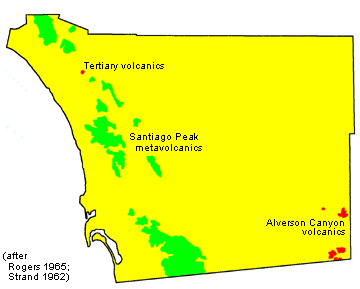Classification of Volcanic Rock
Crystalline volcanic rock was the most frequently used material for flaked lithic artifacts in the prehistoric San Diego region. It was widely available, and its flaking qualities were probably preferred to those of quartz and quartzite, which were also abundant, although not to those of the locally rarer cryptocrystalline silica or imported obsidian. Inconsistencies and inaccuracies in the terms that analysts have used to describe volcanic specimens in archaeological reports have limited the effectiveness of those descriptions for contributing toward the identification of raw material source areas and patterns in lithic resource use.
Basalt, andesite, and rhyolite often appear in the local archaeological literature as terms for specific types of volcanic rock that. According to standard geological usage, these rock types are distinguished on the basis of their mineral and chemical composition, particularly the types of feldspar and the amount of quartz they contain (e.g., Travis 1955). In rhyolite, potassium feldspar predominates; in andesite, sodium feldspar; and in basalt, calcium feldspar. These distinctions are rarely, if ever, been made on the small, weathered specimens that are most prehistoric artifacts. Some archaeological specimens may have been assigned to these categories on the basis of their proximity and similarity to volcanic outcrops that have been analyzed geologically. More commonly, archaeologists apparently used the labels basically as color terms: rhyolite referred to red or brown volcanic rock, andesite, to green or light blue rock; and basalt, to dark blue or black rock. The equation of colors with mineralogically defined categories may often be correct, but it may also be erroneous. Because the categories have not been explicitly defined in the archaeological literature, they do not appear to have been applied at all consistently.
Felsite is another commonly used term. One standard geological definition for felsite is that it is any light-colored volcanic rock (Travis 1955). In local archaeological usage, felsite seems to be intended primarily to refer to fine-grained, green volcanic rock derived from the Santiago Peak formation.
 Volcanic archaeological specimens are often referred to locally as metavolcanic. This is attributable to the prehistoric importance of material from the metamorphosed, pre-Cretaceous Santiago Peak formation (also known as the Black Mountain formation). The process of metamorphosis enriched the Santiago Peak rock in silica, improving its suitability for knapping (Pigniolo 1996). However, evidence of metamorphosis is rarely observable in the archaeological spceimens. Generally lying west of the Santiago Peak outcrops are extensive areas with Cretaceous, Tertiary, and Quaternary marine and nonmarine sedimentary rocks, including conglomerates that contain cobbles of volcanic rock. An example is the Eocene-age Poway Conglomerate, containing river cobbles ultimately derived from Sonora, Mexico. Smaller areas of unmetamorphosed volcanic rocks dating from the Tertiary Period are also present in San Diego County, as well as in surrounding portions of Orange, Riverside, and Imperial counties and, in particular, in northwestern Baja California (Gastil et al. 1971; Rogers 1965; Strand 1962). Because of the probable prehistoric use of unmetamorphosed volcanic rock that may be macroscopically indistinguishable from metavolcanic rock, the use of the more inclusive term of volcanic rock is perhaps preferable.
Volcanic archaeological specimens are often referred to locally as metavolcanic. This is attributable to the prehistoric importance of material from the metamorphosed, pre-Cretaceous Santiago Peak formation (also known as the Black Mountain formation). The process of metamorphosis enriched the Santiago Peak rock in silica, improving its suitability for knapping (Pigniolo 1996). However, evidence of metamorphosis is rarely observable in the archaeological spceimens. Generally lying west of the Santiago Peak outcrops are extensive areas with Cretaceous, Tertiary, and Quaternary marine and nonmarine sedimentary rocks, including conglomerates that contain cobbles of volcanic rock. An example is the Eocene-age Poway Conglomerate, containing river cobbles ultimately derived from Sonora, Mexico. Smaller areas of unmetamorphosed volcanic rocks dating from the Tertiary Period are also present in San Diego County, as well as in surrounding portions of Orange, Riverside, and Imperial counties and, in particular, in northwestern Baja California (Gastil et al. 1971; Rogers 1965; Strand 1962). Because of the probable prehistoric use of unmetamorphosed volcanic rock that may be macroscopically indistinguishable from metavolcanic rock, the use of the more inclusive term of volcanic rock is perhaps preferable.
Porphyritic volcanic rocks are occasionally distinguished from nonporphyritic rocks in archaeological reporting. Porphyries contain two different sizes of mineral grains, the larger of which (the phenocrysts) are macroscopic. It may be possible to attribute porphyritic and nonporphyritic specimens to different source locations, although there do not seem to have been done locally. Nonporphyritic volcanic rock may have been preferred prehistorically, if the phenocrysts in porphyries interfered with flaking control.
Groundmass texture has also been distinguished in archaeological specimens as potentially indicative of the rock’s source area or its flaking properties. Differentiation between coarse- and fine-grained volcanic rock in archaeological analyses has been based on a relative and essentially subjective judgment, and therefore useful for intra- but not inter-assemblage comparisons.
Ian Scharlotta and Tony Quach (2015) have examined the potential of x-ray fluorescence to assign San Diego archaeological specimens to major geological sources, including the Santiago Peak, Jacumba, and Lusardi formations
PROSPECTS
In the future, it may become practical to routinely use microscopic mineralogical or chemical methods on local archaeological specimens in order to identify their source areas. At present, the adoption of a more rigorous and consistent terminology for describing specimens on the basis of their macroscopic properties may make it possible through inter-assemblage comparisons to identify patterns in the prehistoric distribution and uses of different volcanic materials.